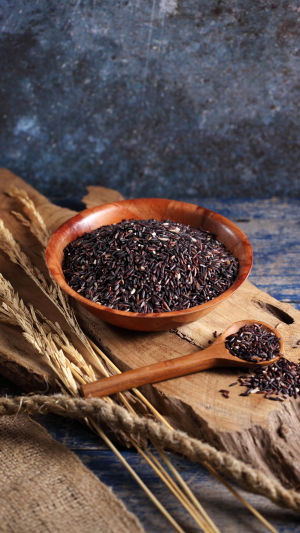Black rice, a monocotyledonous annual grass belonging to the rice genus in the Poaceae family, is characterized by its black or dark brown color.
The rice grains are elongated and appear oval, with a gray-brown husk. The roots, stems, leaves, husk, bran, and endosperm of black rice are all shades of purple or black. The rice is harvested once a year in the autumn.
Black rice, also known as black glutinous rice, gets its name from the dense deposition of pigments, giving it a black and purple hue. The distinctive black color is attributed to the presence of anthocyanins in the outer layer of the rice grain. Research suggests anthocyanins possess potent antioxidant properties, with a more significant antioxidant effect observed in darker colors.
Black rice, the darkest among all rice varieties, thus exhibits excellent antioxidant properties. This antioxidative capability helps protect the body from free radical damage, potentially preventing cancer and aging. Additionally, it shows positive effects in preventing heart diseases.
Furthermore, anthocyanins contain abundant flavonoids, which significantly prevent atherosclerosis—a benefit not found in regular white rice, which lacks substantial flavonoid content. The ability of anthocyanins to enhance vascular elasticity contributes to the effectiveness of black rice in preventing cardiovascular diseases.
Studies indicate that black rice is rich in lutein and zeaxanthin—two carotenoids associated with eye health. These compounds serve as antioxidants, safeguarding the eyes from potential damage caused by harmful free radicals. Lutein and zeaxanthin have been proven to help protect the retina by filtering out harmful blue light.
This antioxidant activity may play a crucial role in preventing age-related macular degeneration (AMD), a leading cause of blindness globally, as well as reducing the risk of cataracts and diabetic retinopathy.
Black rice is an excellent source of protein and fiber, which aid in weight management by reducing appetite and increasing satiety. The anthocyanins found in black rice may contribute to weight and body fat percentage reduction. While research on the role of black rice in human weight loss is limited, a combination of black rice and brown rice is more effective in weight and fat loss than white rice.
Cooking black rice is simple and similar to cooking other types of rice. It involves mixing rice, water, or broth in a saucepan and heating it over medium-high heat. Once boiling, cover the pan, reduce the heat to low, and simmer the rice for 30-35 minutes or until it becomes tender and chewy and all the liquid is absorbed.
Remove the pan from heat, let the rice stand for 5 minutes, then fluff it with a fork before serving. To prevent the rice from becoming sticky during cooking, it is recommended to rinse it with cold water before cooking to remove excess surface starch. Once prepared, black rice can be used in various dishes, such as grain bowls, stir-fries, salads, or rice puddings.
Black rice is not only a nutritionally rich grain. Its deep purple color can transform even the simplest meals into visually stunning dishes when cooked.





